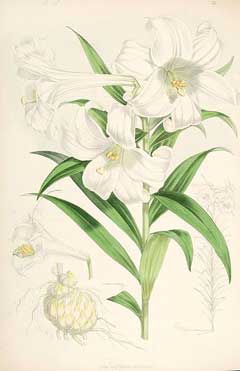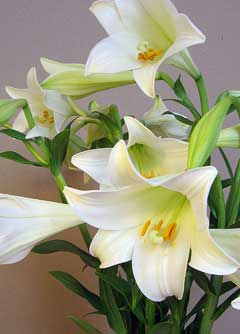 |
|
http://commons.wikimedia.org/wiki/File:Lilium_longiflorum_%28lit%29.jpg |
 |
| http://www.andrewdunnphoto.com/ |
Translate this page:
Summary
Bloom Color: White. Main Bloom Time: Early summer, Late summer, Mid summer. Form: Columnar, Upright or erect.
Physical Characteristics

 Lilium longiflorum is a BULB growing to 1 m (3ft 3in) by 0.3 m (1ft) at a medium rate.
Lilium longiflorum is a BULB growing to 1 m (3ft 3in) by 0.3 m (1ft) at a medium rate.
See above for USDA hardiness. It is hardy to UK zone 5. It is in flower from July to August, and the seeds ripen from September to October. The species is hermaphrodite (has both male and female organs) and is pollinated by Bees.
Suitable for: light (sandy) and medium (loamy) soils and prefers well-drained soil. Suitable pH: mildly acid, neutral and basic (mildly alkaline) soils. It can grow in semi-shade (light woodland) or no shade. It prefers moist soil.
UK Hardiness Map
US Hardiness Map
Synonyms
Plant Habitats
Woodland Garden Sunny Edge;
Edible Uses
Edible Parts: Flowers Leaves Root
Edible Uses:
Bulb - cooked[177]. Mild flavoured and slightly sweet[183]. A starch is also extracted from the bulb[105, 183]. The bulb is 25 - 50mm in diameter[266]. It can be used as a vegetable in similar ways to potatoes(Solanum tuberosum). Young leaves and stems - cooked[105, 177, 183]. Eating the leaves and stems severely harms the vitality of the bulb and is not recommended. Flowers[183]. No further details are given. The flower buds are eaten according to another report[177].
References More on Edible Uses
Medicinal Uses
Plants For A Future can not take any responsibility for any adverse effects from the use of plants. Always seek advice from a professional before using a plant medicinally.
Antiasthmatic Antitussive Expectorant Sedative
The bulb is antiasthmatic, antitussive, expectorant, sedative and tonic (nutritive)[174, 176]. It is used in the treatment of coughs, haemoptysis, insomnia and fidgetiness in the later stage of febrile disease[176].
References More on Medicinal Uses
The Bookshop: Edible Plant Books
Our Latest books on Perennial Plants For Food Forests and Permaculture Gardens in paperback or digital formats.

Edible Tropical Plants
Food Forest Plants for Hotter Conditions: 250+ Plants For Tropical Food Forests & Permaculture Gardens.
More

Edible Temperate Plants
Plants for Your Food Forest: 500 Plants for Temperate Food Forests & Permaculture Gardens.
More

More Books
PFAF have eight books available in paperback and digital formats. Browse the shop for more information.
Shop Now
Other Uses
References More on Other Uses
Cultivation details
Landscape Uses:Container, Specimen. Prefers an open free-draining humus-rich loamy soil with its roots in the shade and its head in the sun[200]. Lime tolerant.[200], plants grow well in limestone soils[260]. Plants deteriorate rapidly if grown in deep shade[143]. A very ornamental plant[1] it is often cultivated for the cut flower trade[260]. It is only hardy outdoors in the mildest areas of Britain and even there needs to be grown in a warm sheltered position with protection from early frosts[143]. The dormant bulbs will withstand soil temperatures down to at least -5°c[214]. It can be grown as an annual, the plants can flower in 6 months from seed[143]. The flowers diffuse a pleasant jasmine-like perfume[245]. Hand pollination is required in order to ensure fertilization[143]. Stem rooting, plant the bulbs 20cm deep[143]. Early to mid autumn is the best time to plant out the bulbs in cool temperate areas, in warmer areas they can be planted out as late as late autumn[200]. The plant should be protected against rabbits and slugs in early spring. If the shoot tip is eaten out the bulb will not grow in that year and will lose vigour[200]. Special Features:Attractive foliage, Suitable for cut flowers, Fragrant flowers, Attractive flowers or blooms. The plant is heat tolerant in zones 9 through 7. (Plant Hardiness Zones show how well plants withstand cold winter temperatures.
Plant Heat Zones show when plants would start suffering from the heat.
The Plant Heat Zone map is based on the number of "heat days" experienced in a given area where the temperature climbs to over 86 degrees F (30°C).
At this temperature, many plants begin to suffer physiological damage. Heat Zones range from 1 (no heat days) to 12 (210 or more heat days).
For example Heat Zone. 11-1 indicates that the plant is heat tolerant in zones 11 through 1.) For polyculture design as well as the above-ground architecture (form - tree, shrub etc. and size shown above) information on the habit and root pattern is also useful and given here if available. The plant growth habit is a clumper with limited spread [1-2]. The root pattern is a bulb.
References Carbon Farming Information and Carbon Sequestration Information
Temperature Converter
Type a value in the Celsius field to convert the value to Fahrenheit:
Fahrenheit:
The PFAF Bookshop
Plants For A Future have a number of books available in paperback and digital form. Book titles include Edible Plants, Edible Perennials, Edible Trees,Edible Shrubs, Woodland Gardening, and Temperate Food Forest Plants. Our new book is Food Forest Plants For Hotter Conditions (Tropical and Sub-Tropical).
Shop Now
Plant Propagation
Seed - immediate epigeal germination[130]. Sow thinly in pots from late winter to early spring in a cold frame. Should germinate in 2 - 4 weeks[163]. Great care should be taken in pricking out the young seedlings, many people prefer to leave them in the seed pot until they die down at the end of their second years growth. This necessitates sowing the seed thinly and using a reasonably fertile sowing medium. The plants will also require regular feeding when in growth. Divide the young bulbs when they are dormant, putting 2 - 3 in each pot, and grow them on for at least another year before planting them out into their permanent positions when the plants are dormant[K]. Division with care in the autumn once the leaves have died down. Replant immediately[200]. Bulb scales can be removed from the bulbs in early autumn. If they are kept in a warm dark place in a bag of moist peat, they will produce bulblets. These bulblets can be potted up and grown on in the greenhouse until they are large enough to plant out[200].
Other Names
If available other names are mentioned here
Native Range
TEMPERATE ASIA: Japan, Kyushu, Ryukyu Islands, Taiwan,Korea.
Weed Potential
Right plant wrong place. We are currently updating this section.
Please note that a plant may be invasive in one area but may not in your area so it's worth checking.
Conservation Status
IUCN Red List of Threatened Plants Status :

Growth: S = slow M = medium F = fast. Soil: L = light (sandy) M = medium H = heavy (clay). pH: A = acid N = neutral B = basic (alkaline). Shade: F = full shade S = semi-shade N = no shade. Moisture: D = dry M = Moist We = wet Wa = water.
Now available:
Food Forest Plants for Mediterranean Conditions
350+ Perennial Plants For Mediterranean and Drier Food Forests and Permaculture Gardens.
[Paperback and eBook]
This is the third in Plants For A Future's series of plant guides for food forests tailored to
specific climate zones. Following volumes on temperate and tropical ecosystems, this book focuses
on species suited to Mediterranean conditions—regions with hot, dry summers and cool, wet winters,
often facing the added challenge of climate change.
Read More
Expert comment
Author
Thunb.
Botanical References
200
Links / References
For a list of references used on this page please go here
Readers comment
| Add a comment |
|
If you have important information about this plant that may help other users please add a comment or link below. Only comments or links that are felt to be directly relevant to a plant will be included. If you think a comment/link or information contained on this page is inaccurate or misleading we would welcome your feedback at [email protected]. If you have questions about a plant please use the Forum on this website as we do not have the resources to answer questions ourselves.
* Please note: the comments by website users are not necessarily those held by PFAF and may give misleading or inaccurate information.
To leave a comment please Register or login here All comments need to be approved so will not appear immediately.
|
Subject : Lilium longiflorum
|
|
|
|